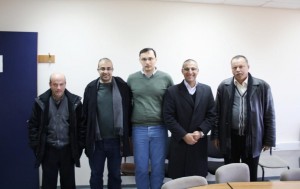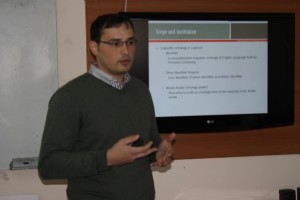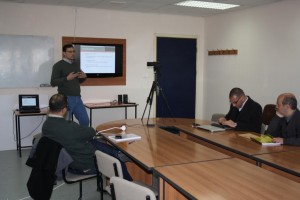Mr. Mohammed Melhem defended his Master thesis under the supervision of Dr. Mustafa Jarrar, and committee members Dr. Bassem Sayrafi and Dr. Hashem Tamimi. The title of the thesis is: Advanced Matching Function towards linking Arabic Ontology with the English WordNet.

Mr. Mohammed, who is a researcher at in Sina institute, presented his thesis, illustrating his work of enhancing and reengineering the performance of the Matching Function by using Neural Networks and Machine Learning techniques.
The thesis first presented an overview about WordNet and the current state of the Arabic Ontology, focusing on discussing the tools used to build it. Then it demonstrated how machine learning was introduced to the Matching Function, by innovating a new, revised and improved Matching algorithm.
The major challenge in constructing an Arabic ontology is that it needs many resources, manual work, and semi-manual techniques that require creating a sophisticated tool to ease the process. Such a tool should provide the technique and ability to link and benefit from other existing linguistic resources. This tool will be used to link between concepts from different multilingual resources, based on the concept matching function. The matching function is an algorithm that was developed in Sina Institute-Birzeit University, by undergraduate students. It maps Arabic concepts in the Arabic Ontology with their equivalent concepts in the English WordNet. This first version of the function carries a certain level of tolerance, but suffers from some limitations in the matching process as it uses fixed parameters. These parameters are categorized into two main categories of weighing parameters that include; Keyword, Super Type, Sub-type, and Synonyms as its main parts. The second category is the expansion levels of processed data by this function.
Mr. Mohammad’s thesis introduced a novel approach to enhance the Matching Function, by increasing the accuracy of matching operation, minimizing the resulted errors, and increasing the performance of the algorithm. The presented solution utilizes machine-learning techniques to configure and tune the mentioned parameters. The followed methodology resulted in an enhancement on the matching operation by a percentage of 7% against this thesis experiment.

















